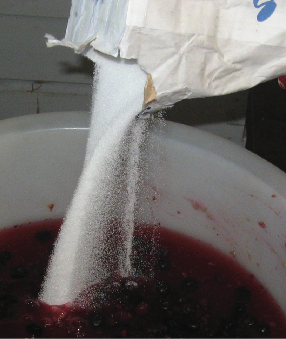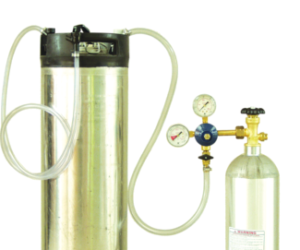
Jean-Antoine Chaptal lacked one major benefit we enjoy today: The work in microbiology by Louis Pasteur. (Chaptal lived from 1756 to 1832 and Pasteur lived from 1822 to 1895.) Chaptal was, nonetheless, a brilliant chemist in his era and he introduced many improvements to industrial processes over the course of his lifetime. The one for which he is remembered among winemakers today is the addition of sugar to must in order to achieve a higher final alcohol in the wine. As a term, chaptalization is sometimes applied to the sweetening of a finished wine as well, but today’s article addresses it only for fermenting in must.
So where does Pasteur come in? It happens that Chaptal reached a valid conclusion based on what we now consider faulty science. In the eighteenth century, wine was not very stable and spoilage was a serious concern that limited distribution and commerce. Chaptal observed that adding sugar to must, especially in cool regions or cold growing years, could produce wine that was more stable and aged better. His theory for this action postulated two major antagonistic components in grape must: One was sugar and the other was “ferment.” In the fermentation of wine, sugar and “ferment” annihilated each other, leaving alcohol. A shortage of sugar was thought to then leave an excess of “ferment,” which tended to spoil. Many years later, Pasteur elucidated the process by which yeast converts sugar to alcohol — no need for a self-destructive “ferment.” What Chaptal had inadvertently developed, though, was a means of achieving higher alcohol levels from low-sugar musts. Wine with higher alcohol is more stable than low-alcohol wine. The results were right, he just got the mechanism wrong.
Today, with our more thorough understanding of wine fermentation, we know that yeast converts sugar to alcohol in a fairly fixed ratio. Nearly all of the sugar in grape must is glucose and fructose, at essentially equal concentrations. Each of these sugars may be represented by the formula C6H12O6 and has a molar mass of 180 g/mol. Ethanol, the product of fermentation, has the formula C2H6O and has a molar mass of 46 g/mol.
Represented as a chemical equation, the overall description of alcoholic fermentation of sugar is:
C6H12O6 ⇒ 2(C2H6O) + 2(CO2)
Since ethanol has a molar mass of 46 and two molecules are produced from one sugar molecule, we are converting every 180 g of sugar into 2 x 46 or 92 g of ethanol. This equation represents the maximum theoretical yield of alcohol, with 92 g representing 51% of the starting sugar weight. In practice, though, about 2.5% of the sugar is used by the yeast in its life processes and another 5% or so is converted into other byproducts such as glycerol. Together these effects lower the yield to about 85 g per mole of sugar, for a yield (by weight) of about 47%. Because we usually refer to alcohol by volume in wine and ethanol is less dense than water, the yield by volume calculates with a larger factor and may be estimated as about 0.55 times the starting sugar content. To estimate the potential alcohol by volume from a particular must, we can start with the weight concentration of sugar (expressed as °Brix) and multiply by 0.55. Your individual results may vary, of course. There are minor differences in yield with different yeast strains. High fermentation temperatures — especially in an open-top red wine fermenter — may drive off some ethanol as vapor. For planning a sugar addition to must, 0.55 works reasonably well. It is that planned addition that constitutes chaptalization.
Commercially, winemakers encounter several scenarios in which they practice sugar addition. Typically, winemaking laws allow chaptalization in jurisdictions that frequently experience difficulty getting grapes ripe or in places where low-sugar grapes may thrive. In Germany, for instance, with its cool Northern climate, adding sugar is a routine part of winemaking. German winemakers must label their wines to indicate if they are “natural” or not, “natural” indicating no added sugar. French winemakers can also chaptalize and need not label the wine. US federal law allows for chaptalization, but (as with so many US alcohol laws), states can write in their own restrictions. In a cool climate like Oregon, sugar addition is permitted. Chaptalization is also permitted in Florida, where the local Muscadine grape is often too low in sugar to make a stable wine. In warm, sunny California, adding sugar to the must is prohibited, except that grape concentrate may be added.
There is another exception for the secondary fermentation of sparkling wine, where sugar is allowed everywhere — even in California.
In making wines from fruits other than grapes, producers almost always add sugar. Strawberry must, for instance, may be as low as 5 °Brix, even when fully ripe. Some plums may get as high as 16 °Brix, but no other fruit reliably rises to the 20 °Brix+ that is considered normal for wine grapes. Even beyond conventional fruits, wines may be made (with sugar additions) from a wide variety of vegetables, herbs, or plants. In Modern Winemaking, Philip Jackisch notes that many of these ultimately amount to “sugar wine,” with the other base ingredients used primarily as flavoring agents.
The same uses, and more, apply to home winemakers. As a group, we face much less onerous regulations and can experiment a bit more freely. So if you are growing wine grapes in a region that is a bit too cool, go ahead and consider adding sugar. Similarly, if you can sometimes get ripe grapes, but one year comes up short, it is time to chaptalize. In my own hobby vineyard in southern Sonoma County, California, I can usually get my Pinot Noir and Chardonnay grapes ripe enough for stable wine, although I often wait until October to harvest them. Most years, the Pinot comes in at 23–24 °Brix and the Chardonnay at 21–23 °B. In 2011, we had a cold, rainy harvest season on the North Coast of California. I acquired some Charbono grapes from Mendocino County and was grateful to get them. The sugar, though, was a little low — about 19 °Brix, so I chaptalized! I only raised the sugar to about 21 °Brix (we will talk more about calculations, later) because I wanted the final alcohol to be in balance with the rest of the cool-climate characteristics of the wine. It was likely to have higher acid and lower fruitiness compared to a warm growing season so excessively high alcohol might prove unpleasant. It turned out to make an excellent, if light, red table wine. The commercial producer of Charbono with those same grapes mixed in some much riper Petite Sirah to produce another delicious wine, in a bigger style.
If you do not have some ripe Petite Sirah (or some other grapes) to help with a low-sugar must but you want to make a big red, you can turn to concentrate. In 2012, I picked my Pinot Noir at typical harvest Brix and made a nice table wine out of most of it. In late winter, realizing I was going to have plenty of Pinot, I decided to try an experiment with some of it. My brother has complained that my Pinot lacks “oomph” and he is right. It is, after all, Pinot Noir and is grown in a cool climate. It is clear ruby red, not inky dark. It is high in acid and modest in alcohol. To make a wine he might like better, I brought home a 46-ounce can of Petite Sirah concentrate that had been packaged at 68 °Brix. I stirred that into 5 gallons (19 L) of finished Pinot Noir wine that was about 13% ABV. I added a strong yeast strain (Uvaferm 43) since this was going to be a difficult ferment. I tucked away the 6.5-gallon (25 L) carboy in a warm kitchen cabinet and left it for two months. I had the finished “Oomph” wine tested at a wine laboratory when it finally went dry again: 15.7% ABV and 7.2 g/L TA. It’s big, it’s dark — and my brother likes it!
Another novel application for adding sugar at home is if you have grapes that, due to variety or growing conditions, are too high in acid. For instance, Frontenac grown in Northern climates may reach adequate sugar levels, but have titratable acidity (TA) too high for balanced wine. Instead, you can add water to the must until the TA level is diluted into a suitable winemaking range — that technique is called “amelioration.” Of course, you will have diluted the sugar as well if you use this technique. So now you can chaptalize the must back up to a reasonable Brix level and hopefully ferment a balanced wine. For commercial producers, the Tax and Trade Bureau (TTB) limits the water addition to 35% volume/volume and the final TA must remain greater than or equal to 5 g/L.
At home, you can do what you like. However, if you go much beyond these limits, you may lose significant contributions to flavor, aroma, and mouthfeel.
An expansion on traditional techniques that you can apply at home is the making of specialty wines that rely on high-Brix musts. Suppose, for instance, that you have some nice ripe Zinfandel at 25 °Brix, but that is not quite high enough to make a sweet late-harvest wine with an adequate sugar level. If you want to simulate a “late harvest,” go ahead and add sugar to reach, say, 32 °Brix and achieve perhaps 16% ABV with 3% sugar left over for sweetness:
32° starting Brix – 3° residual Brix = 29 °Brix consumed
29 °Brix x 0.55 (our factor from above) = 16% ABV
If you choose a yeast rated to 14% or 15% alcohol tolerance, meaning it is likely to go just a bit higher, it may well stop by itself at 16%. You have a faux “late harvest” Zinfandel dessert wine.
Or suppose you live in a place where the grapes never freeze, but you love icewine-style wines. Canada is one of the world’s leading producers of genuine Icewine. Varieties such as Vidal, Riesling, or even Cabernet Franc are left on the vine at the end of the growing season until the first freeze arrives. They are picked and pressed frozen, so only the high-sugar, high-acid juice (sort of natural anti-freeze) is expressed. The resulting wine is very sweet but still refreshing because of its high acidity. If you have access to one of these varieties, there are two ways you can simulate the real thing. One is to put buckets of grapes in your chest freezer until they reach just the right level of “frozen” and then press them. Unfortunately, home wine presses do not usually exert enough pressure to do this very well. The other choice relies on our old friend Jean-Antoine Chaptal. Add sugar to conventionally pressed juice to reach about 35 °Brix (the Canadian minimum for the real stuff) and tartaric acid to over 10 g/L. Plan on a long ferment — sugar that high makes it very difficult for yeast to work.
Finally, there are those fruit, herb, and vegetable wines mentioned by Jackisch. Add as much water as you need to get the volume of wine you intend to make, and then adjust your acid and sugar levels to make a balanced wine. If you use fruit that is sweet enough, the 35% water addition limit imposed by TTB on grape wines would be a good guideline. For something like dandelion wine, though, you will need to add essentially 100% of the water and 100% of the sugar.
For practical chaptalization, the most frequent use in winemaking remains raising the must sugar by two or three degrees Brix to make a balanced wine from a slightly deficient must. When adding sugar, even to a red wine must, you are really interested in just the juice yield, since that is where the sugar will go. Measure the sugar level with a refractometer or hydrometer and decide on your target level. Since °Brix is “percent sugar by weight,” you are calculating percent sugar to add.
The simple formula can be expressed in pounds or in kilograms, depending on your preference.
lbs. of sugar to add = (lbs. of juice) x [(desired °Brix – actual °Brix)/100]
or:
kg of sugar to add = (kg of juice) x [(desired °Brix – actual °Brix)/100]
For white wine juice, you know (or can estimate) the volume directly. To get pounds or kilograms, though, you need to know the density. Either measure specific gravity (SG) directly, or use a formula or calculator to convert from °Brix to SG.
lbs. of juice = gallons of juice x 8.33 x SG
or:
kg of juice = L of juice x SG
For red wine, you will need to estimate your juice yield. This will usually be done on the basis of grape weight, factoring in the likely production of wine when maceration and pressing are complete. For most red varieties using home winemaking equipment, a reasonable expectation is about 6.5 gallons (25 liters) of wine for every 100 lbs. (45 kg) of fruit. With experience, you may be able to modify this factor for your particular grapes. There are varietal influences, with small-berry varieties like Cabernet Sauvignon often coming in lower and larger berries like Zinfandel somewhat higher. Nonetheless, this figure will work as a starting point. Apply the same specific gravity formula listed above for white juice and add sugar accordingly.
Saccharomyces wine yeasts are generally considered glucophilic; faced with a mixture of glucose and fructose in a must, they will consume the glucose faster. (See this article for a discussion of what that does to residual sweetness.) For purposes of increasing alcohol, adding glucose will provide the fastest fermentation supplement. Glucose is readily available at home winemaking shops in the form of corn sugar, also known as dextrose. You may also use cane or beet sugar — sucrose. At juice pH, it will hydrolize into equal amounts of glucose and fructose. To add one of these dry sugars, you want to minimize any water addition. A good way to proceed is to weigh out your needed sugar and dissolve it in a minimum amount of the juice you are chaptalizing. Then mix the resulting syrup into the whole mass.
If chaptalizing with concentrate, the sugar is already dissolved. You will need to find out the sugar content of the concentrate you are using. One manufacturer reports that their concentrate, marked as 68 °Brix, contains 840 g of sugar in every liter of concentrate. Once you have calculated the grams you need, apply the following formula to determine liters of that concentrate:
L of concentrate to add = g of sugar needed/840
If your concentrate has a different °Brix level, use the supplier’s information to determine the grams of sugar per liter of concentrate. Substitute your value for 840 in the above expression. Measure the volume of concentrate and stir it into the juice or must.
Whether you use concentrate, corn sugar, or sucrose, there are mixed opinions among experts on when to chaptalize. In his book Techniques in Home Winemaking, Daniel Pambianchi writes, “Add the sugar progressively in stages.” He explains that this procedure will avoid inhibiting the yeast with too high a starting gravity and will avoid sudden overheating of a too-vigorous ferment. The technique could be very important if you are trying to make a very high sugar addition. If you are making only a small sugar addition, you may instead want to follow the advice of Emile Peynaud in Knowing and Making Wine. Peynaud says, “It is better to sugar in one step before half the sugar in the must has been transformed, that is to say, during the rapid fermentation phase.”
Whichever way you do it, you will know what is really happening to your wine, thanks to Louis Pasteur. You can correct deficiencies in a must caused by climate, seasonal weather, or varietal limitations. You can make a “sugar wine” flavored with anything from kiwi fruit to green tea. Or you can look to specialty styles of high-sugar wines made around the world and chaptalize your way to a fashion statement!






